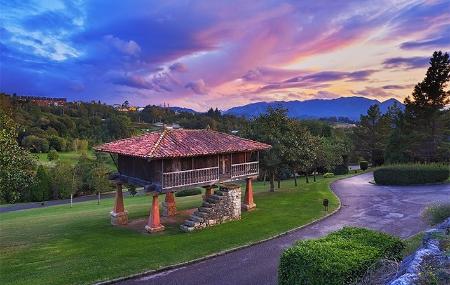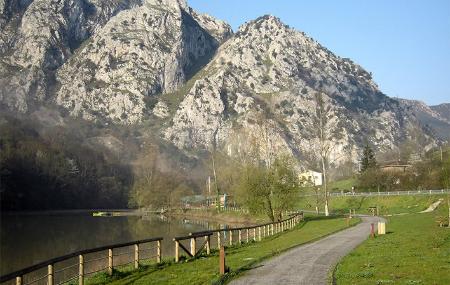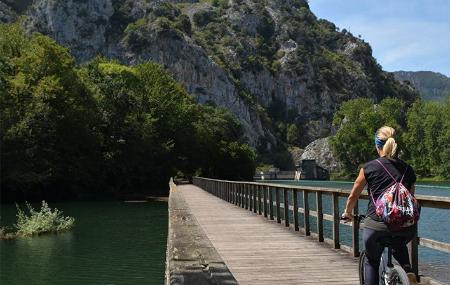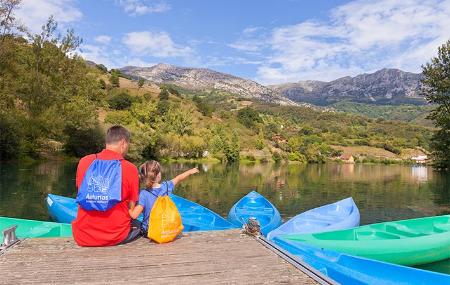
Oviedo to Valdemurio Reservoir
- Address Oviedo and Quirós Asturias Centre
- Distance Distance: 60 kms
- Difficulty Difficulty: Short
- Mountain bike Mountain bike: 1 day
- Start point Start point: Oviedo/Uviéu
- Route type Route type: mtb
- Tour type Tour type: Linear
- Layout of the route Layout of the route: Download kml, Download gpx
Route
Oviedo/Uviéu - Valdemurio Dam 60
This cycling tour is linear, starting and finishing at a different point (although it can be made circular by changing the starting/arrival point).
The route runs almost entirely along greenways. Half of the route is on asphalt and the other half on a track, which makes it suitable for all types of bicycles. It is a nice route, very quiet, a little long if you don't cycle often, but easy if you are used to riding a little. It does not have big slopes.
An easy and quiet route following the valleys of the rivers Nalón and Trubia. Very good for quiet cycling in a natural environment.
There are many variants of this route, as the outward and return journeys coincide. Therefore, it could be made as a circular route leaving and arriving in Oviedo (lengthening the route), or leaving and arriving in Trubia (shortening the route). Another variant would be to take another of the routes of the Senda del Oso. This path is in the shape of a Greek y. It starts in the recreational area of Tuñón (Santo Adriano), with a common section of 10 km, which crosses the Council of Proaza, to later fork into two different valleys, the Valley of Quirós, ending in Santa Marina, and the Valley of Teverga, ending in Entrago.
Leave Oviedo through the Parque de Invierno, taking the greenway in the direction of Las Caldas; from here follow a road that runs alongside the River Nalón, signposted as a cycle path (Fuso-Tuñón), with almost no traffic. Once in Trubia, take a road that follows the river Trubia, also signposted as a cycle path (Fuso-Tuñón). In the recreational area of Tuñón it links up with the famous Senda del Oso.
The Senda del Oso or also known as Ruta del Oso, occupies the old platform of a mining railway, which linked Teverga and Quirós with Trubia (40 km.) and which stopped working in the middle of the 20th century, being partially reconverted (about 25 kms) in the mid 90s into a cycle and hiking trail. It is a path in an area of great natural and scenic beauty, with lush forests, the river running alongside us, and spectacular views.
Shortly after starting the trail, near Villanueva you can visit the bear enclosure with an area of 5 ha: in it live the bears Paca and Tola, which were once requisitioned from evil poachers, and the bear Furaco. A good time to see them is around 12 o'clock, as the keepers feed them in an enclosure near the path.
Continue along the path and in Proaza, you can see several interesting buildings such as the Torre del Campo, Palacio de los González Tuñón or del Campo from the Baroque period, Palacio de los González Tuñón (18th century) and the medieval Torre del Campo (15th century).Further on, in Caranga de Abajo, the path forks into two branches: towards San Martín (Teverga) and the one we are taking today, towards Santa Marina (Quirós), passing by the Valdemurio reservoir. Taking this branch and almost at the end of the path, we reach the Valdemurio reservoir where we can stop for lunch and spend some time.
The Valdemurio reservoir, also called the Quirós reservoir, is suitable for water sports (e.g. canoeing) and fishing. On its banks and in the surrounding area you can enjoy a wide range of activities such as hiking or cycle touring and relax in its recreational areas. The reservoir is located in the heart of Las Ubiñas - La Mesa Natural Park, which is mainly supplied by two rivers, the Quirós and the Teverga.
It is supplied directly from the former, and from the latter via a four-kilometre-long conduit dug under the mountain, which begins at the Oliz weir. To make the return journey, simply go back the way you came. On this excursion, the arrival point is the town of Trubia, which has a train station.
Trubia is known for being home to the Royal Trubia Arms Factory. Founded in 1794 and still active, it is one of the most interesting testimonies to the heritage of industrialisation in Spain. Due to the economy generated by the factory, Trubia was a very different town from the rest of Spain, as in the 19th century it had a theatre, a casino, a language school, a polyphonic choir and a music band.
Map
Itinerary
Oviedo - Las Caldas - Trubia - Villanueva - Proaza - Caranga de Abajo - Santa Marina - Valdemurio Dam




